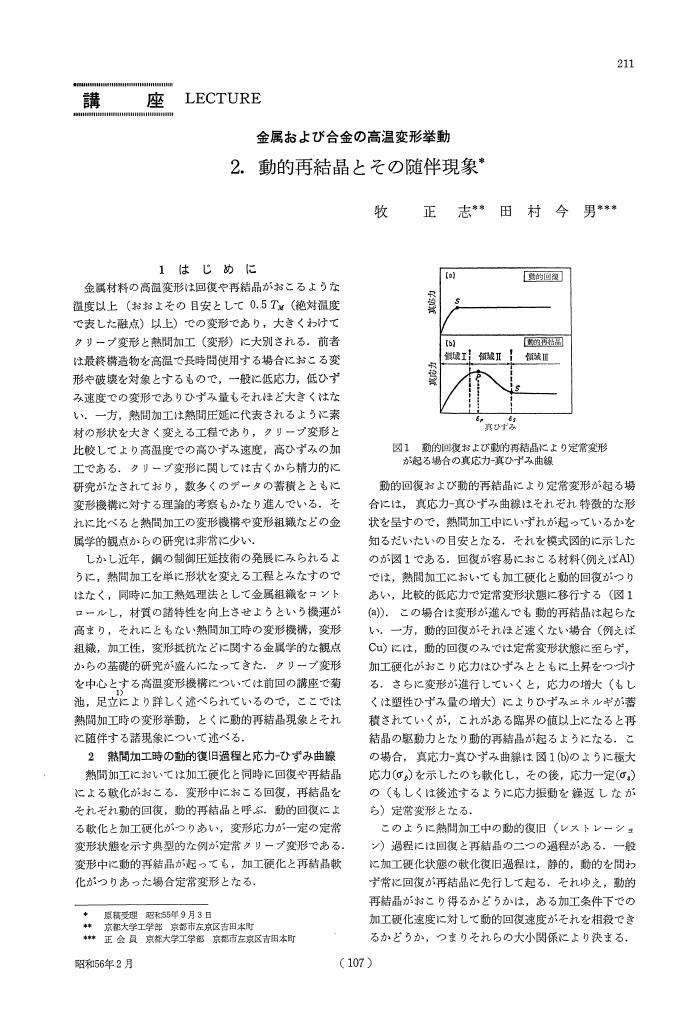2 0 0 0 OA 金属および合金の高温変形挙動
- 著者
- 牧 正志 田村 今男
- 出版者
- 公益社団法人 日本材料学会
- 雑誌
- 材料 (ISSN:05145163)
- 巻号頁・発行日
- vol.30, no.329, pp.211-217, 1981-02-15 (Released:2009-06-03)
- 参考文献数
- 35
- 被引用文献数
- 8 11
1 0 0 0 OA ベイナイトの等温変態挙動とその連続冷却変態への適用
- 著者
- 梅本 実 堀内 一也 田村 今男
- 出版者
- The Iron and Steel Institute of Japan
- 雑誌
- 鉄と鋼 (ISSN:00211575)
- 巻号頁・発行日
- vol.68, no.3, pp.461-470, 1982-03-01 (Released:2009-06-19)
- 参考文献数
- 23
- 被引用文献数
- 22 25
To obtain a general cooling transformation kinetics of steels from its isothermal transformation kinetic data, a bainite transformation has been investigated in present study. The main results obtained are as follows:(1) The isothermal transformation behaviour of bainite for the steel used in present investigation (JIS, SUJ2) can be expressed by the Johnson-Mehl type equation.(2) The bainite trasformation is retarded with an increase in the austenite grain size. The nucleation site of bainite is mainly on austenite grain surface but some homogeneous nucleations in the matrix are also found.(3) The equation expressing the transformation bahaviour of bainite during continuous cooling has been derived from the experimentally obtained isothermal transformation kinetics. It is examined that this equation well expresses the actual continuous cooling transformation behaviour.(4) The above result showing that additivity rule for transformed fraction is hold for bainite transformation during continuous cooling and cooling transformation behaviour can weell be predicted using the isothermal transformation kinetics.
1 0 0 0 OA 二相混合組織をもつ鉄合金の強度と延性について
- 著者
- 田村 今男 友田 陽 山岡 幸男 金谷 三郎 小沢 正俊 赤尾 明
- 出版者
- The Iron and Steel Institute of Japan
- 雑誌
- 鉄と鋼 (ISSN:00211575)
- 巻号頁・発行日
- vol.59, no.3, pp.454-468, 1973-03-01 (Released:2010-10-12)
- 参考文献数
- 21
- 被引用文献数
- 40 15
The strength and ductility of two-phase iron alloys with a ductile second phase were studied. The alloys used in this investigation were classified in three groups, that is, Fe-Cr-Ni alloys composed of austenite and ferrite, Fe-Ni-C alloys composed of austenite and martensite, and Fe-C alloys composed of ferrite and martensite; these phases had various volume fractions.The main results obtained are as follows:(1) In case of Fe-Cr-Ni alloys having different volume fractions of phases, when the same heat treatment was given, the better combination of strength and elongation was obtained in two-phase alloys than in single-phase alloys of austenite or ferrite. The main cause of this behavior was the difference in grain size. The coarsening of grains in two-phase alloys was much slower than that in single-phase alloys.(2) The effects of grain size on strength were shown by Petch type relations even in two-phase alloys as well as in single phase ones.(3) The effect of the volume fraction of phases on tensile properties with nearly the same grain size depended on the difference between the tensile properties of the second phase and the matrix. As the ratio of the 0.2% proof stress of the second phase to that of the matrix became larger than about 3, the relationb etween 0.2% proof stress and the volume fraction became to deviate from a linear relationship; this is known as the law of mixture. This may be caused by the difference of strains in the second phase and the matrix which becomes larger with an increase of the ratio.
1 0 0 0 OA 鋼の連続冷却変態の速度論
- 著者
- 梅本 実 田村 今男
- 出版者
- The Iron and Steel Institute of Japan
- 雑誌
- 鉄と鋼 (ISSN:00211575)
- 巻号頁・発行日
- vol.68, no.3, pp.383-392, 1982-03-01 (Released:2009-06-19)
- 参考文献数
- 42
- 被引用文献数
- 4 4
1 0 0 0 OA 鋼の連続冷却変態の速度論
- 著者
- 梅本 実 田村 今男
- 出版者
- 社団法人日本鉄鋼協会
- 雑誌
- 鐵と鋼 : 日本鐡鋼協會々誌 (ISSN:00211575)
- 巻号頁・発行日
- vol.68, no.3, pp.383-392, 1982-03-01
1 0 0 0 OA 連続冷却途中での冷却速度変更にともなうパーライト変態挙動
- 著者
- 清水 信善 田村 今男
- 出版者
- 一般社団法人 日本鉄鋼協会
- 雑誌
- 鉄と鋼 (ISSN:00211575)
- 巻号頁・発行日
- vol.61, no.10, pp.2375-2390, 1975-08-01 (Released:2010-10-12)
- 参考文献数
- 13
- 被引用文献数
- 4
In this investigation, the pearlitic transformation behaviour of steel with the cooling rate discontinuously altered during continious cooling was studied in relation to the CCT diagram of the steel. The main results are as follows:(1) The pea litic transformation behaviour with the cooling rate discontinuously altered during continuous cooling was diffe-ent from the transformation behaviour illustrated by usual CCT diagram.(2) The pearlitic transformation behaviour and the critical cooling rate with the cooling rate altered at a point during continuous cooling were observed to be related to the incubation period consumed before changing the cooling rate.(3) Including the degree of consumed incubation period in usual CCT diagram as a parameter, the transformation behaviour and the critical cooling rate can be estimated from a conventional CCT diagram.(4) If the same amount of the incubation period was consumed by either continuous cooling or isothermal holding, the transformation behaviour was virtually the same in subsequent cooling when the cooling started from the same temperature.

